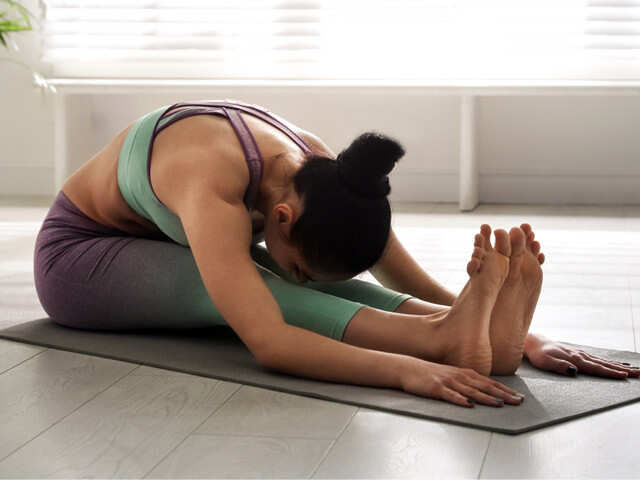
Image: Shutterstock
Paschimottanasana is a seated forward bend – a sitting position that stretches the hamstrings and back muscles by folding the upper body forward over the legs. Three Sanskrit roots are used to create the word – paschima, which means ‘back’, uttana, which means ‘stretch’, and asana, which means ‘seat’ or ‘posture’.
One of the three primary scriptures of Hatha yoga, the Gheranda Samhita, has the earliest description of Paschimottanasana in its second chapter. Out of the 84,00,000 postures indicated, this was chosen as one of the top 32 for us to practice. Gorakshanath, a yogi, promoted this asana.
In addition to being a component of the Ashtanga main series, Paschimottanasana is frequently practised in sessions that follow the Hatha, Vinyasa, and Restorative styles.
Benefits Of Paschimottanasana
How To Do Paschimottanasana
Beginners’ Tips
Other Asanas That Help To Prepare
Variations
Who Should Not Practice?
Frequently Asked Questions:

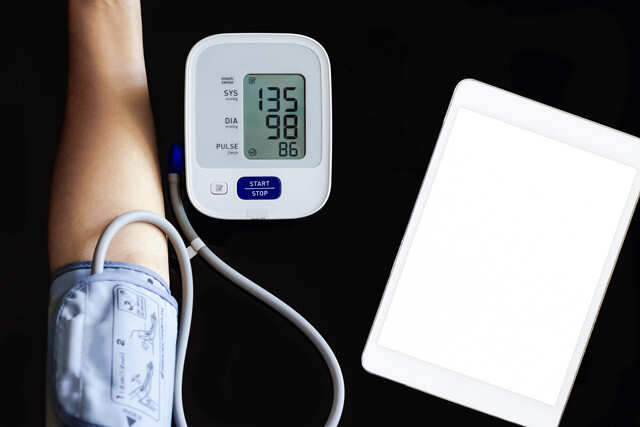 Image: Shutterstock
Image: Shutterstock
People with diabetes and hypertension might benefit from practising paschimottanasana. One must perform Paschimottanasana every day in the early morning in order to receive all of its benefits as it is helpful to do this yoga asana on an empty stomach and bowels.
Tip: Eat your meals at least four to six hours prior to doing the asana so that you have the energy to do it. It’s also better to avoid eating right after doing it.
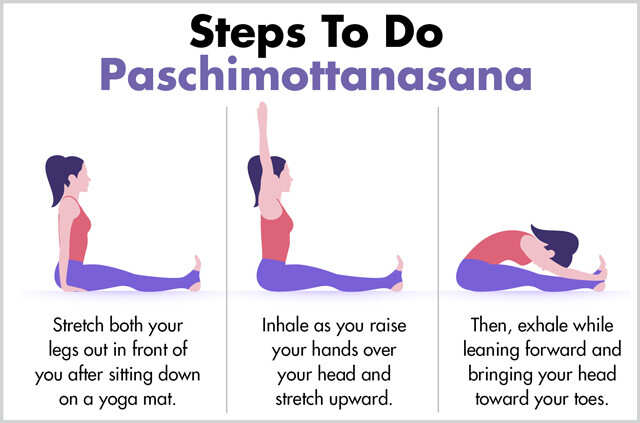
Tip: If you are unable to exercise in the morning, you can practise in the evening.
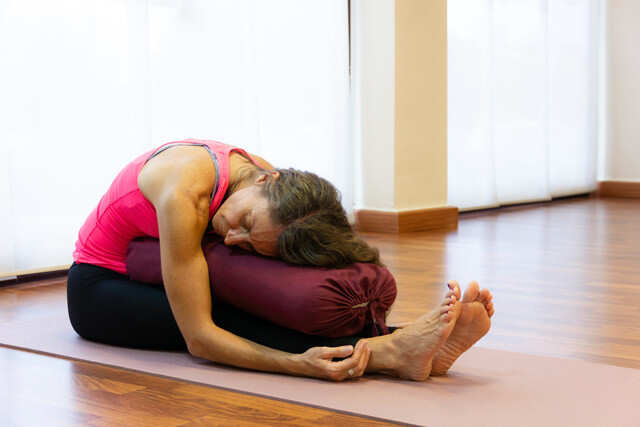 Image: Shutterstock
Image: Shutterstock
Tip: Paschimottanasana should be held for a minimum of one to three minutes in order to get the full benefits of the position.
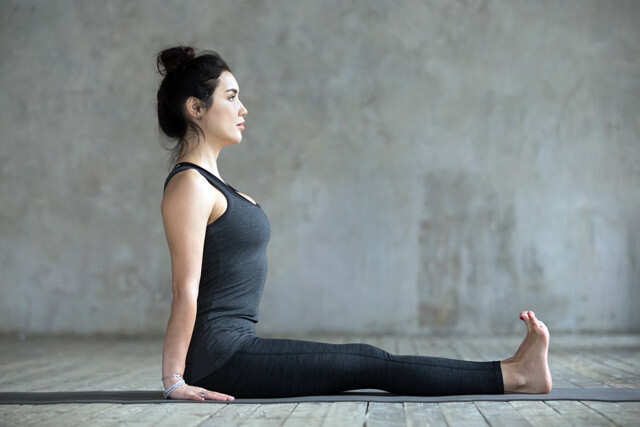 Image: Shutterstock
Image: Shutterstock
Since a yoga posture takes a few weeks of practice to master, you can take the assistance of a few easier poses. These below-mentioned poses will prepare you for Paschimottanasana by creating a sequence that leads up to this pose.
Tip: Find your own rhythm once you practice and learn these all for the best benefits.
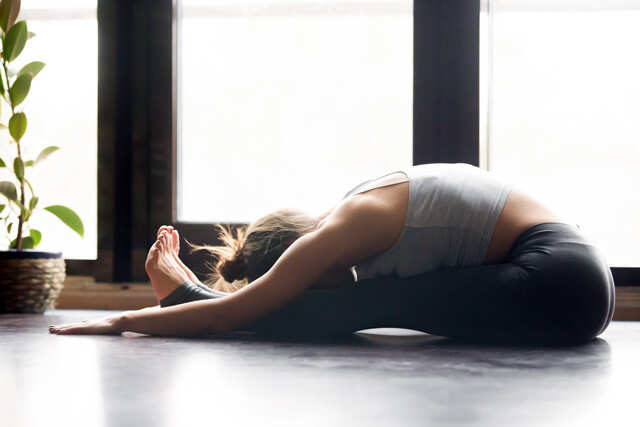 Image: Shutterstock
Image: Shutterstock
A modified variation of Paschimottanasana is the caterpillar pose that is often performed in accordance with the Yin School Of Yoga. It not only benefits the spine and the stomach, but also the underlying muscles of the back and the stomach. Additionally, since the caterpillar pose is a straightforward sitting yoga position, the deeper tendons and tissues around the spine, as well as the abdominal region are simultaneously stretched and compressed.
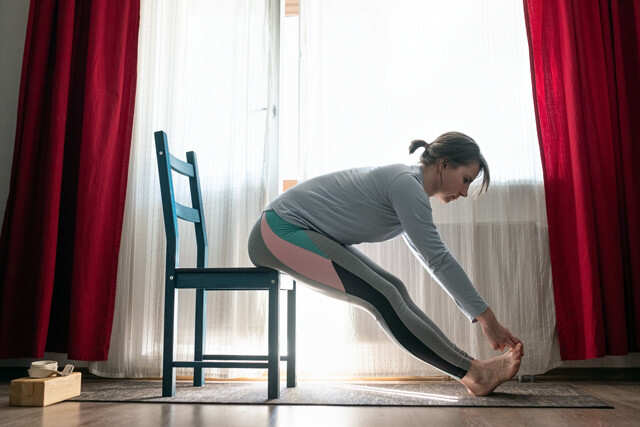 Image: Shutterstock
Image: Shutterstock
As the name implies, Paschimottansana Chair (Seated Forward Bend Pose Chair) is a variant of Paschimottanasana, performed with the assistance of the chair. This variation may be used to assist in gradually loosening up the stiff hamstrings and lower back in beginners who find it difficult to reach a forward bend.
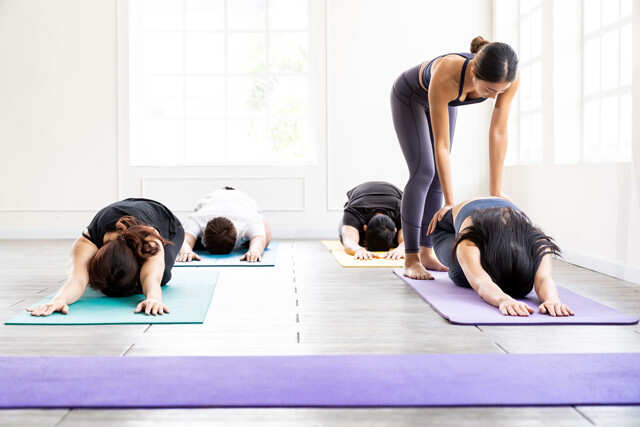 Image: Shutterstock
Image: Shutterstock
Tip: If the posture leads to discomfort even after being practised for a while, then look for another posture.
Knee bends are strictly discouraged since doing so negates the benefits of practising the sitting forward bend and makes it difficult to try to arch your back when bending. This is due to the fact that your back should constantly be relaxed and eased; otherwise, bending may result in issues.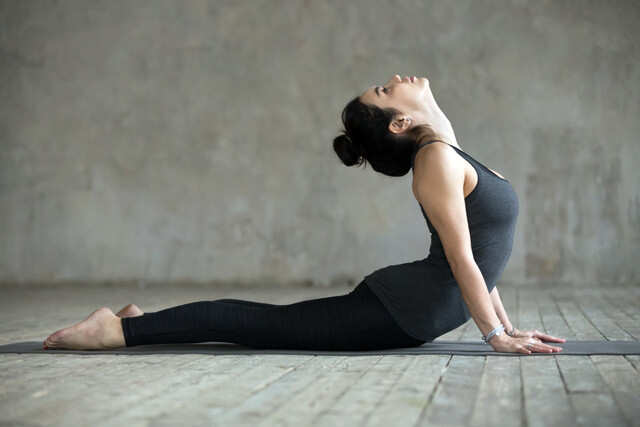 Image: Shutterstock
Image: Shutterstock
A. Some of the follow up poses for Paschimottanasana are Suptavajrasana, Bhujangasana, Shalabhasana, Ardha Ustrasana, Ustrasana, Vakrasana, Ardha Matsyendrasana.
Paschimottanasana is a seated forward bend – a sitting position that stretches the hamstrings and back muscles by folding the upper body forward over the legs. Three Sanskrit roots are used to create the word – paschima, which means ‘back’, uttana, which means ‘stretch’, and asana, which means ‘seat’ or ‘posture’.
One of the three primary scriptures of Hatha yoga, the Gheranda Samhita, has the earliest description of Paschimottanasana in its second chapter. Out of the 84,00,000 postures indicated, this was chosen as one of the top 32 for us to practice. Gorakshanath, a yogi, promoted this asana.
In addition to being a component of the Ashtanga main series, Paschimottanasana is frequently practised in sessions that follow the Hatha, Vinyasa, and Restorative styles.
Benefits Of Paschimottanasana
How To Do Paschimottanasana
Beginners’ Tips
Other Asanas That Help To Prepare
Variations
Who Should Not Practice?
Frequently Asked Questions:
Benefits Of Paschimottanasana

Improves Body Flexibility
The yoga position Paschimottanasana is renowned for being excellent for general body flexibility. It is a healthy bending stretch that helps your entire body and is recognised in contemporary yoga and workout manuals as the ‘intense dorsal stretch’ due to its severity.Provides Relief From Physical Ailments
One of the finest Hatha yoga poses, Paschimottanasana is recognised for its ability to stretch out any form of physical ailment in the human body.Beneficial For Those With Anxiety
As a soothing pose for the mind and neurological system, Paschimottanasana is said to be beneficial for anxiety and depression. It is contemplative by nature and may be used with deep breathing exercises to create a more meditative atmosphere.Helps Those Suffering From Diabetes And Hypertension

People with diabetes and hypertension might benefit from practising paschimottanasana. One must perform Paschimottanasana every day in the early morning in order to receive all of its benefits as it is helpful to do this yoga asana on an empty stomach and bowels.
Here are some additional benefits of Paschimottanasana:
- Combats obesity
- Assists with digestive issues
- Regulates menstrual cycle and discomforts associated with menopause
- Helps to gain energy
- Assists with concerns about being underweight
- Effective in the treatment of neurological conditions
- Aids in building muscle strength
- Helps reduce depression
- Used in the treatment of insomnia
Tip: Eat your meals at least four to six hours prior to doing the asana so that you have the energy to do it. It’s also better to avoid eating right after doing it.
How To Do Paschimottanasana

The Paschimottanasana is an easy pose and can be done by most people. Just follow these simple steps:
- Stretch both your legs out in front of you after sitting down on a yoga mat. Ensure that your spine is straight and your toes are flexed.
- Inhale as you raise your hands over your head and stretch upward.
- Then, exhale while leaning forward and bringing your head toward your toes. You can either hold your feet in this position or rest your hands on your legs. Allow your arms to stretch forward without exerting effort.
- After that, you should lower your head to your knees and exhale slowly as you do so.
- Ensure to lengthen your spine forward when attempting to reach toward your legs.
- Breathe and extend your arms in front of you. As you breathe in, return to your sitting position from where you started.
- As you exhale, drop your arms and release the stance.
Tip: If you are unable to exercise in the morning, you can practise in the evening.
Beginners’ Tips
It takes some time and practice to master the skill to do the Paschimottanasana correctly. However, bending forward past a certain point can lead to excruciating back discomfort.- To begin with, one should bend as far forward as is comfortable. Paschimottanasana may be performed after improving the suppleness and flexibility of the back muscles.
- Keep in mind that asanas are perfected over time and beginners should not rush or forcefully try to perform an asana as it can cause muscle sprains or tears.

- Meanwhile, taking some assistance could make the asana more comfortable in the beginning stages. A bolster may be put on the thighs to support the torso and provide a more restorative variation of the pose, enabling the individual to hold the position for much longer.
- To increase the stretch, people having tight hamstrings will need to keep their knees bent. Those unable to touch their feet may utilise a yoga strap wrapped over the balls of their feet to prevent putting unwanted stress on the hamstrings.
- A rolled-up blanket placed beneath the hips might support the pelvis towards a more solid position if the posture causes the back to feel round.
Tip: Paschimottanasana should be held for a minimum of one to three minutes in order to get the full benefits of the position.
Other Asanas That Help To Prepare

Since a yoga posture takes a few weeks of practice to master, you can take the assistance of a few easier poses. These below-mentioned poses will prepare you for Paschimottanasana by creating a sequence that leads up to this pose.
- Dandasana
- Uttanasana
- Janu Sirsasana
- Balasana
- Shashankasana
- Yoga mudra
Tip: Find your own rhythm once you practice and learn these all for the best benefits.
Variations
Below are some alternatives or modified poses to practise instead of Paschimottanasana.The Caterpillar Pose

A modified variation of Paschimottanasana is the caterpillar pose that is often performed in accordance with the Yin School Of Yoga. It not only benefits the spine and the stomach, but also the underlying muscles of the back and the stomach. Additionally, since the caterpillar pose is a straightforward sitting yoga position, the deeper tendons and tissues around the spine, as well as the abdominal region are simultaneously stretched and compressed.
Seated Forward Bend Pose Chair

As the name implies, Paschimottansana Chair (Seated Forward Bend Pose Chair) is a variant of Paschimottanasana, performed with the assistance of the chair. This variation may be used to assist in gradually loosening up the stiff hamstrings and lower back in beginners who find it difficult to reach a forward bend.
Who Should Not Practice?

Paschimottanasana should not be practised under the following conditions:
- In case you are experiencing slipped disc concerns
- If you have spondylitis
- If you are suffering from an injury that is affecting your spine
- While you are pregnant
- When facing hernia problems
- Those suffering from asthma
Tip: If the posture leads to discomfort even after being practised for a while, then look for another posture.
Frequently Asked Questions:
Q. How many minutes we should do Paschimottanasana?
A. To get the maximum benefits of Paschimottanasana, it should be held for a minimum of one to three minutes.Q. Does Paschimottanasana increase height?
A. Yes. Paschimottanasana, which is centered on stretching and focuses on flexibility, might help you grow taller.Q. What are the dos and don’ts of Paschimottanasana?
A. To make the posture simpler, attempt to touch your toes with your hands and try to extend your nose all the way to your knees. That is definitely the way to go about this. Beginners can use the assistance of bolsters, folded blankets, or yoga blocks for support.Knee bends are strictly discouraged since doing so negates the benefits of practising the sitting forward bend and makes it difficult to try to arch your back when bending. This is due to the fact that your back should constantly be relaxed and eased; otherwise, bending may result in issues.
Q. What do you do after Paschimottanasana?

A. Some of the follow up poses for Paschimottanasana are Suptavajrasana, Bhujangasana, Shalabhasana, Ardha Ustrasana, Ustrasana, Vakrasana, Ardha Matsyendrasana.
Next Story